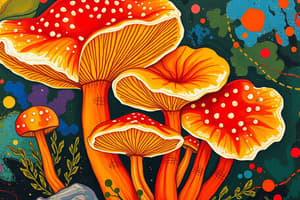Podcast
Questions and Answers
Which of the following is a mode of asexual reproduction in yeast cells?
Which of the following is a mode of asexual reproduction in yeast cells?
- Binary fission
- Budding (correct)
- Conjugation
- Fragmentation
What is the typical shape of a yeast cell?
What is the typical shape of a yeast cell?
- Square
- Round to oval (correct)
- Star-shaped
- Triangular
Which of the following fungal groups is known for producing mushrooms?
Which of the following fungal groups is known for producing mushrooms?
- Rhizopus sp.
- Yeasts
- Molds
- Puffballs (correct)
What type of cells are found in the bodies of molds or filamentous fungi?
What type of cells are found in the bodies of molds or filamentous fungi?
Which fungal group is characterized by having long, threadlike cells called hyphae?
Which fungal group is characterized by having long, threadlike cells called hyphae?
What is the unique clublike structure that defines the phylum Basidiomycota?
What is the unique clublike structure that defines the phylum Basidiomycota?
In the life cycle of a basidiomycete, what structure contains four haploid nuclei?
In the life cycle of a basidiomycete, what structure contains four haploid nuclei?
What is the main method of reproduction in basidiomycetes involving the fusion of male and female strains?
What is the main method of reproduction in basidiomycetes involving the fusion of male and female strains?
Which term refers to a chain of yeasts formed when buds remain attached in a row?
Which term refers to a chain of yeasts formed when buds remain attached in a row?
What is the structure that makes up the body or colony of a mold?
What is the structure that makes up the body or colony of a mold?
Which type of hypha is responsible for digesting and absorbing nutrients in fungi?
Which type of hypha is responsible for digesting and absorbing nutrients in fungi?
What type of spores are formed on the outside of a basidium?
What type of spores are formed on the outside of a basidium?
Which fungal division is characterized by incomplete septate hyphae and produces basidiospores?
Which fungal division is characterized by incomplete septate hyphae and produces basidiospores?
What is the sexual spore formed after the fusion of two opposite strains in some fungi?
What is the sexual spore formed after the fusion of two opposite strains in some fungi?
Which type of conidium is a spherical conidium formed by the thickening of a hyphal cell?
Which type of conidium is a spherical conidium formed by the thickening of a hyphal cell?
What is the main function of algae in lichens?
What is the main function of algae in lichens?
In which fungal division may the septa be incomplete and produce conidia?
In which fungal division may the septa be incomplete and produce conidia?
What is a characteristic feature of conidia that distinguishes them from other types of spores?
What is a characteristic feature of conidia that distinguishes them from other types of spores?
'Blastospore' is a spore produced by budding from what type of parent cell?
'Blastospore' is a spore produced by budding from what type of parent cell?
'Microconidium' and 'macroconidium' are formed by the same fungus under what conditions?
'Microconidium' and 'macroconidium' are formed by the same fungus under what conditions?
What is the key characteristic of zygospores that distinguishes them from other sexual spores?
What is the key characteristic of zygospores that distinguishes them from other sexual spores?
Study Notes
Asexual Reproduction in Yeast Cells
- Budding is a mode of asexual reproduction in yeast cells.
Yeast Cell Characteristics
- Yeast cells are typically oval or spherical in shape.
Fungal Groups
- The fungal group known for producing mushrooms is Basidiomycota.
Mold and Filamentous Fungi Cell Types
- Hyphae cells are found in the bodies of molds or filamentous fungi.
Fungal Group Characteristics
- Filamentous fungi are characterized by having long, threadlike cells called hyphae.
Phylum Basidiomycota Characteristics
- The unique clublike structure that defines the phylum Basidiomycota is a basidium.
Basidiomycete Life Cycle
- The basidium contains four haploid nuclei in the life cycle of a basidiomycete.
- The main method of reproduction in basidiomycetes involves the fusion of male and female strains.
Yeast Cell Characteristics
- Pseudohyphae is a chain of yeasts formed when buds remain attached in a row.
Mold Body Structure
- The body or colony of a mold is made up of a mycelium.
Hyphae Functions
- Absorptive hyphae are responsible for digesting and absorbing nutrients in fungi.
Basidium Characteristics
- Basidiospores are formed on the outside of a basidium.
Fungal Divisions
- The fungal division characterized by incomplete septate hyphae and produces basidiospores is Basidiomycota.
- The fungal division where the septa may be incomplete and produce conidia is Ascomycota.
Sexual Spores
- Zygospores are the sexual spores formed after the fusion of two opposite strains in some fungi.
- The key characteristic of zygospores is that they are thick-walled and resistant to environmental stress.
Conidium Characteristics
- A spherical conidium formed by the thickening of a hyphal cell is a chlamydospore.
- A characteristic feature of conidia that distinguishes them from other types of spores is that they are produced from the tips of specialized hyphae.
Lichens
- The main function of algae in lichens is to provide nutrients through photosynthesis.
Conidium Formation
- Microconidium and macroconidium are formed by the same fungus under different environmental conditions.
- Blastospore is a spore produced by budding from a yeast parent cell.
Studying That Suits You
Use AI to generate personalized quizzes and flashcards to suit your learning preferences.
Description
Test your knowledge of fungal groups, cell morphology, and organization including microscopic fungi, molds, yeasts, pseudohyphae, dimorphic fungi, colonies, and mycelium.




